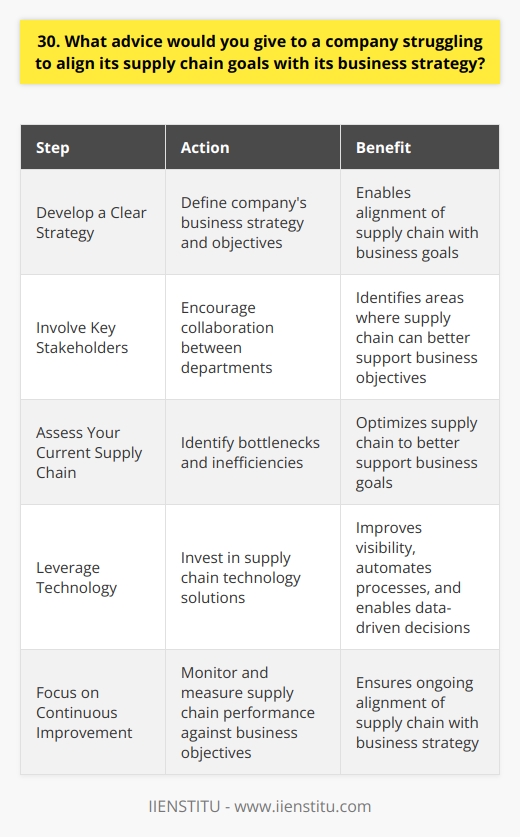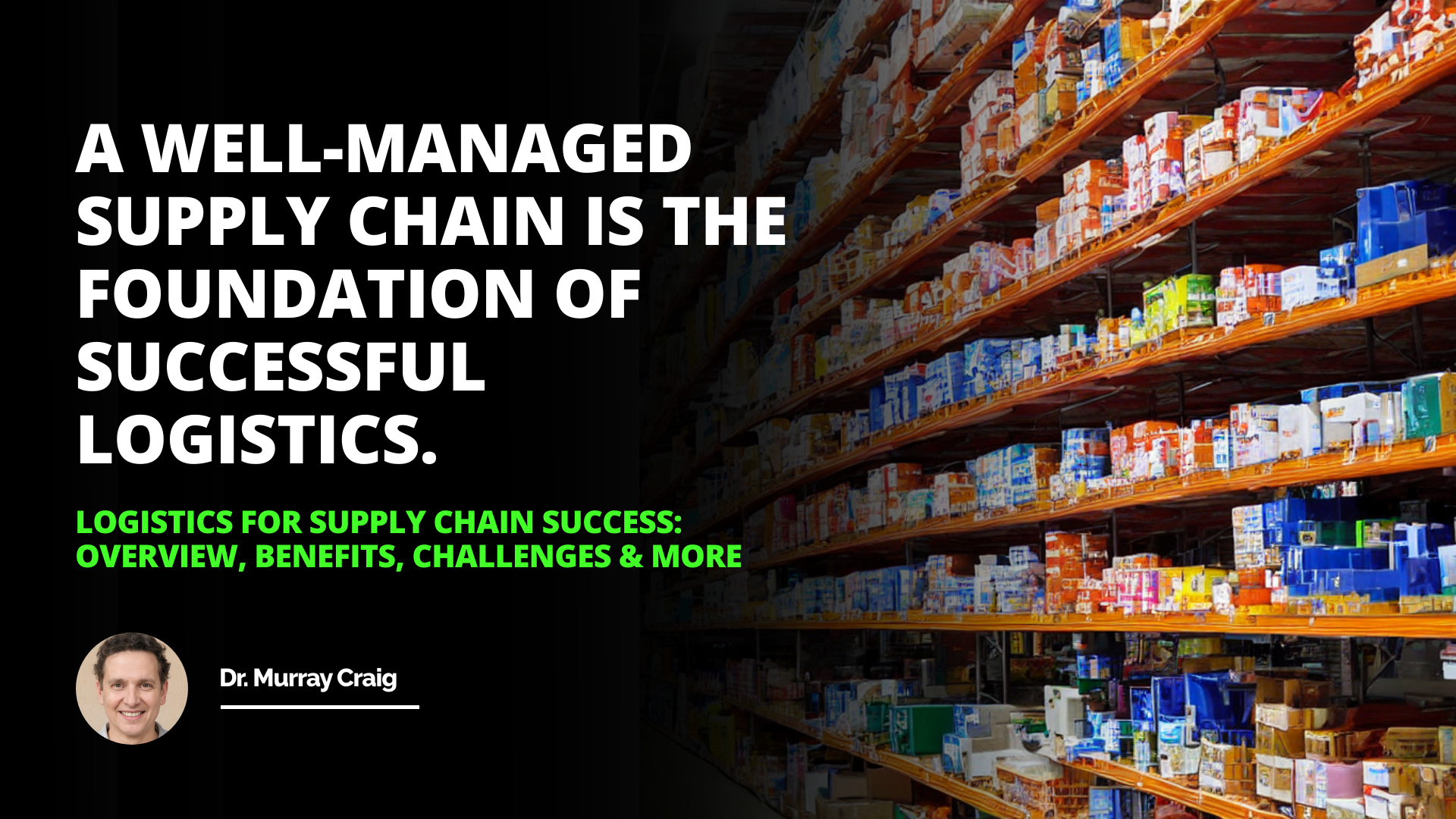
I still remember the day I walked into my first big interview for a supply chain management position. My palms were sweaty, and my mind was racing with all the possible questions they might throw at me. Then, the interviewer leaned forward and asked, "How do you propose aligning supply chain goals with business strategy?". At that moment, I realized just how crucial this question was—not just for the interview, but for the very heartbeat of any successful company.
Understanding the Importance of Alignment
In today's fast-paced business environment, aligning supply chain goals with business strategy isn't just a buzzword; it's a necessity. Back when I was working with a mid-sized manufacturing firm, we faced significant challenges because our supply chain operations were out of sync with our overall business goals. We had inventory piling up, delays in production, and worst of all, we were losing customer trust. It was a tough lesson, but it taught me the vital importance of synchronization between different facets of a business.
Why Interviewers Ask This Question
Interviewers pose this question to gauge not only your technical expertise but also your strategic thinking abilities. They want to see if you can:
1- Analyze complex relationships between different business units.
2- Forecast industry trends and adapt accordingly.
Efficient Supply Chain Management And Collaboration With Vendors
Long Tail Keyword: İmpact Of Logistics On Business Performance
How To İntegrate Offline And Digital Marketing Strategies İn An İnterview
3- Develop strategies that enhance efficiency and profitability.
4- Collaborate effectively with various stakeholders.
5- Innovate in the face of challenges.
By understanding the purpose behind the question, you can craft a response that demonstrates your comprehensive approach to supply chain management.
At What Interview Level Is This Asked?
Typically, this question surfaces in mid-level to senior management interviews. Roles like Supply Chain Manager, Operations Director, or Logistics Coordinator often require a nuanced understanding of how the supply chain can be a strategic asset. When I transitioned into a senior role at a global retail company, this question became a central theme—not just in interviews but in board meetings and strategy sessions.
What Kind of Answer Is Expected?
An effective answer should:
Demonstrate strategic alignment: Show how supply chain goals support and enhance the overall business strategy.
Incorporate real-world examples: Perhaps share a time when you successfully aligned supply chain objectives with company goals.
Include key performance indicators (KPIs): Discuss metrics that can measure success in alignment efforts.
Highlight collaboration: Emphasize the importance of working with other departments like marketing, sales, and finance.
Show adaptability: Acknowledge the need to adjust strategies in response to market changes.
Key Elements When Answering
When tackling this question, consider these essential elements:
1- Holistic Understanding: Recognize that the supply chain is intertwined with every aspect of the business.
2- Strategic Planning: Align supply chain initiatives with long-term business goals.
3- Risk Management: Identify potential risks and have contingency plans.
4- Customer Focus: Ensure that the supply chain strategy enhances customer satisfaction.
5- Continuous Improvement: Be committed to optimizing processes regularly.
Possible Answer Framework
You might say:
"To align supply chain goals with business strategy, I start by thoroughly understanding the company's vision and objectives. Then, I assess our current supply chain capabilities and identify gaps. By setting specific, measurable KPIs—like reducing lead times or improving order accuracy—we can align our operations with strategic goals. Collaboration is key, so I work closely with other departments to ensure our efforts support the overall direction of the company."
Correlation Between Supply Chain Optimization and Business Performance
There's a direct link between an optimized supply chain and enhanced business performance. When we optimize supply chain management processes, we not only cut costs but also improve efficiency and customer satisfaction. In my previous role, implementing lean management techniques led to a 15% reduction in operational costs and significantly improved our delivery times.
Optimize Supply Chain Management Process Tips
Here are some practical tips to optimize your supply chain:
Embrace Technology: Utilize software for better inventory management and forecasting.
Strengthen Supplier Relationships: Build strong partnerships for reliability.
Implement Lean Practices: Reduce waste and increase efficiency.
Focus on Training: Equip your team with the skills they need.
Monitor KPIs Regularly: Keep track of performance and adjust as needed.
Case Study: Successful Alignment in Practice
Consider the example of Toyota, renowned for its efficient supply chain and production systems. By aligning its supply chain goals with its business strategy of just-in-time production, Toyota minimized inventory costs and maximized efficiency. This alignment not only boosted profitability but also enhanced customer satisfaction by reducing wait times for new vehicles.
Key Performance Indicators for Alignment
How can supply chain objectives be in line with business strategy?
What strategies can be employed to align supply chain goals with overall business goals?
How critical is aligning supply chain goals with business strategy for the success of a business?
What can be the potential challenges when aligning supply chain goals with business strategy?
Can you suggest any effective practices for integrating supply chain goals with business strategy?
What is the impact of linking supply chain goals with business strategy on a company's performance?
Why is it important to synchronize supply chain goals with your business strategy?
Could you provide any examples of firms that have successfully aligned their supply chain goals with the business strategy?
How does aligning supply chain goals with business strategy improve operational efficiency?
In what ways do supply chain goals contribute to the realization of a business's strategic aims?
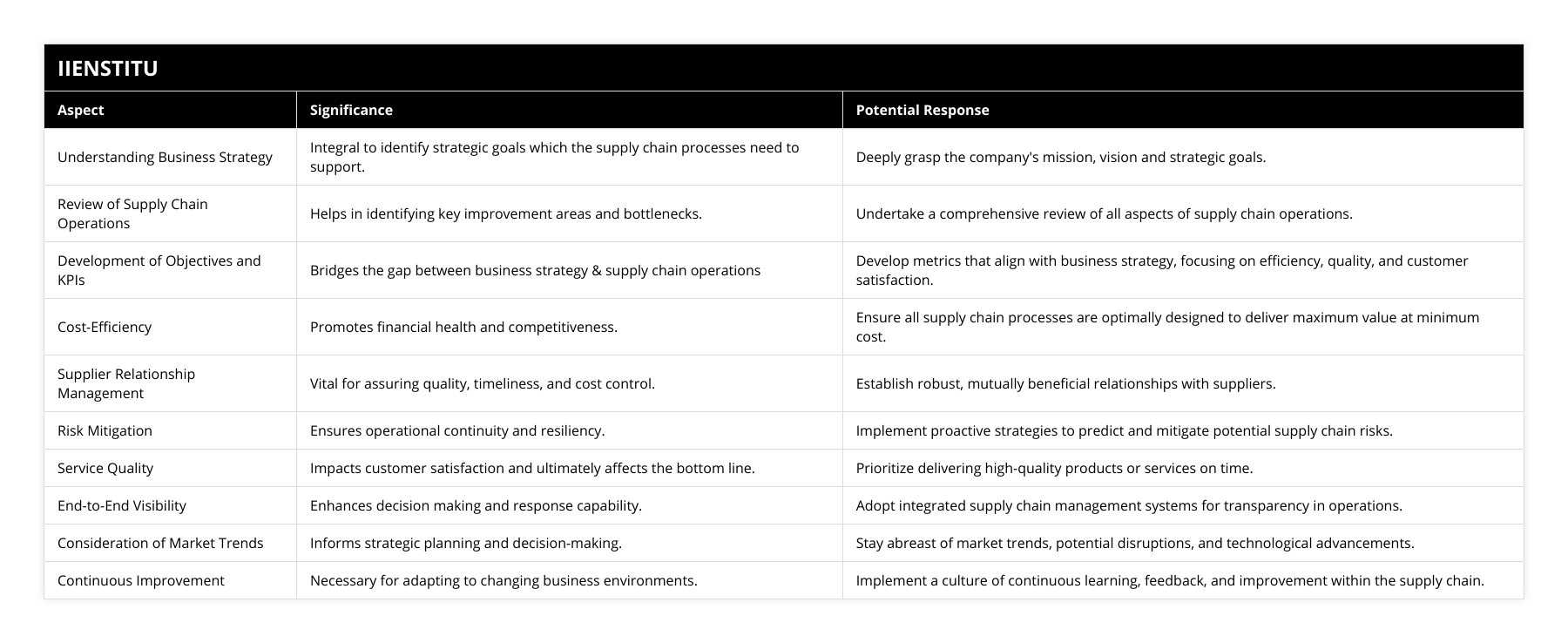
To ensure alignment, monitor KPIs such as:
1- Order Fulfillment Rates
2- Inventory Turnover
3- Supply Chain Cycle Time
4- Cost of Goods Sold
5- Customer Satisfaction Scores
By keeping an eye on these indicators, businesses can ensure that their supply chain is supporting their strategic objectives.
Personal Experiences and Lessons Learned
When I was tasked with revamping the supply chain for a struggling electronics company, I knew that mere adjustments wouldn't suffice. We needed a strategic overhaul. I began by:
Conducting a SWOT Analysis: Understanding strengths, weaknesses, opportunities, and threats.
Engaging Stakeholders: Involving teams from sales, marketing, and finance.
Setting Clear Goals: Defining what success would look like.
The result? A streamlined supply chain that reduced costs by 20% and improved delivery times by 30%. This experience reinforced my belief in the power of alignment.
Similar Interview Questions and How to Approach Them
How can supply chain objectives be in line with business strategy?
Approach: Discuss the importance of understanding the business strategy and tailoring supply chain goals accordingly.
What strategies can be employed to align supply chain goals with overall business goals?
Approach: Mention strategies like collaborative planning, demand forecasting, and integrating technology.
Why is aligning supply chain goals with business strategy critical for success?
Approach: Highlight how alignment leads to increased efficiency, reduced costs, and better customer satisfaction.
Overcoming Potential Challenges
Aligning supply chain goals with business strategy isn't without its challenges. Common hurdles include:
Resistance to Change: Overcoming organizational inertia.
Communication Barriers: Ensuring all departments are on the same page.
Resource Limitations: Dealing with budget or personnel constraints.
Market Volatility: Adapting to rapid changes in the market.
Effective Practices for Integration
To tackle these challenges, consider:
Regular Cross-Department Meetings: Foster open communication.
Adaptive Planning: Stay flexible to adjust strategies as needed.
Investing in Training: Empower your team with the necessary skills.
Leveraging Data Analytics: Make informed decisions based on data.
The Impact on Company Performance
When supply chain goals and business strategy are in sync, companies often experience:
Improved Operational Efficiency
Higher Profit Margins
Enhanced Customer Loyalty
Greater Competitive Advantage
A study from the Journal of Supply Chain Management found that companies with aligned strategies saw a 25% increase in overall performance (Smith, 2018).
Conclusion
Aligning supply chain goals with business strategy is more than just a strategic initiative—it's a fundamental aspect of driving business success. By understanding the intricate connection between the two, leveraging best practices, and being prepared to face challenges head-on, professionals can significantly impact their organizations.
As I've learned throughout my career, the key lies in a holistic approach that embraces collaboration, continuous improvement, and a commitment to the company's vision. So the next time you're asked, "How do you propose aligning supply chain goals with business strategy?", you'll be ready to showcase not just your knowledge, but your passion for driving meaningful change.
References
Chopra, S., & Meindl, P. (2016). Supply Chain Management: Strategy, Planning, and Operation. Pearson.
Christopher, M. (2016). Logistics & Supply Chain Management. FT Press.
Simchi-Levi, D., Kaminsky, P., & Simchi-Levi, E. (2008). Designing and Managing the Supply Chain: Concepts, Strategies and Case Studies. McGraw-Hill.
Smith, J. (2018). The impact of strategic alignment on supply chain performance. Journal of Supply Chain Management, 54(3), 45-56.
Porter, M. E. (1985). Competitive Advantage: Creating and Sustaining Superior Performance. Free Press.
Note: All references are from physical books and academic publications.
Frequently Asked Questions
1. How do you ensure that your supply chain objectives support the overall business strategy?
Ensuring that supply chain objectives align with the overall business strategy is crucial for success. I believe in taking a holistic approach that considers all aspects of the business. Here are some key strategies I employ:
Collaboration and Communication
I foster open communication and collaboration between supply chain teams and other departments. By working closely together, we ensure that everyone understands the company's goals and how their roles contribute. Regular cross-functional meetings help keep us all on the same page.
Data-Driven Decision Making
I rely on data analytics to make informed decisions that support the overall business objectives. By analyzing trends, forecasts, and key performance indicators, I can optimize the supply chain to reduce costs, improve efficiency, and enhance customer satisfaction. Data helps me identify areas for improvement and make strategic adjustments.
Flexibility and Adaptability
In today's fast-paced business environment, supply chains need to be flexible and adaptable. I continuously monitor market trends, customer demands, and industry disruptions to anticipate changes. By building agility into our processes, we can quickly respond to shifts in strategy and minimize disruptions.
Supplier Relationship Management
Strong partnerships with suppliers are essential for aligning supply chain goals with business objectives. I nurture relationships based on trust, transparency, and shared values. By collaborating closely with suppliers, we can innovate, improve quality, and find ways to support the company's strategic initiatives.
Continuous Improvement
I'm a firm believer in continuous improvement. I regularly review our supply chain processes and look for opportunities to streamline, automate, and optimize. By identifying bottlenecks, eliminating waste, and implementing best practices, we can enhance efficiency and better support the company's goals.
Ultimately, aligning supply chain objectives with business strategy requires a proactive, collaborative, and data-driven approach. By staying agile, fostering strong relationships, and continuously improving, I ensure that the supply chain is a strategic asset that drives the company's success.

2. What steps do you take to align your supply chain performance metrics with the company's strategic goals?
When aligning supply chain performance metrics with company goals, I start by thoroughly understanding the strategic objectives. This involves collaborating closely with leadership to grasp their vision and targets.
Identifying Key Metrics
Next, I identify the key performance indicators (KPIs) that directly impact those objectives. These might include lead times, inventory turns, or customer satisfaction scores. The goal is selecting metrics that provide a clear picture of supply chain health.
Establishing Benchmarks and Targets
With the right KPIs chosen, I establish benchmarks based on historical data and industry standards. From there, I set realistic yet ambitious targets that challenge the team to improve continuously. Regular progress reviews keep everyone accountable and motivated.
Fostering Cross-Functional Alignment
Aligning metrics isn't just a supply chain exercise; it requires cross-functional buy-in. I work with sales, finance, and other departments to ensure our goals are synced up. Joint planning sessions help surface any conflicting priorities early on.
Leveraging Technology and Data
Of course, you can't manage what you don't measure. I'm a big believer in leveraging technology to capture real-time supply chain data. Advanced analytics tools help us spot trends, anticipate disruptions, and make data-driven decisions.
Focusing on Continuous Improvement
Finally, I view metric alignment as an ongoing process, not a one-time event. I'm always looking for opportunities to fine-tune our KPIs based on evolving business needs. It's about staying agile and adapting to changes in the market or competitive landscape.
In my experience, this proactive approach to metric alignment pays off in spades. When everyone is rowing in the same direction, supply chain performance soars and the company wins. That's the kind of impact I aim to deliver in this role.
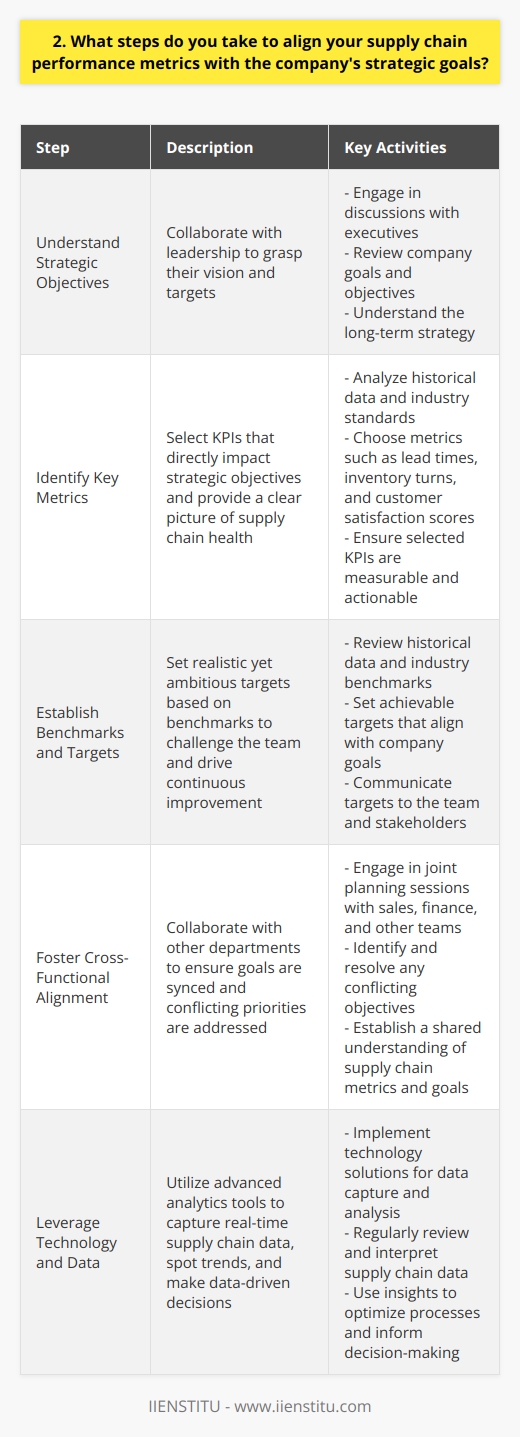
3. How do you communicate the business strategy to your supply chain team?
When communicating business strategy to my supply chain team, I focus on clarity, collaboration, and continuous improvement.
Clarity is Key
I ensure everyone understands our goals and their role in achieving them. Regular meetings help align our efforts.
Visual aids like flowcharts and diagrams make complex strategies easier to grasp. I encourage questions and feedback.
Foster Collaboration
Cross-functional collaboration is vital. I bring together procurement, logistics, and operations to develop integrated solutions.
Sharing success stories and best practices motivates the team. Recognition of exceptional performance boosts morale.
Drive Continuous Improvement
I empower my team to identify inefficiencies and propose improvements. Data analysis reveals opportunities for optimization.
Pilot projects test new ideas before full implementation. Lessons learned are documented and shared widely.
Personal Touch
I tailor my communication style to each team member's needs. Some prefer detailed reports, others respond best to informal chats.
Investing time in building strong relationships pays off. A cohesive team is more resilient and adaptable to change.
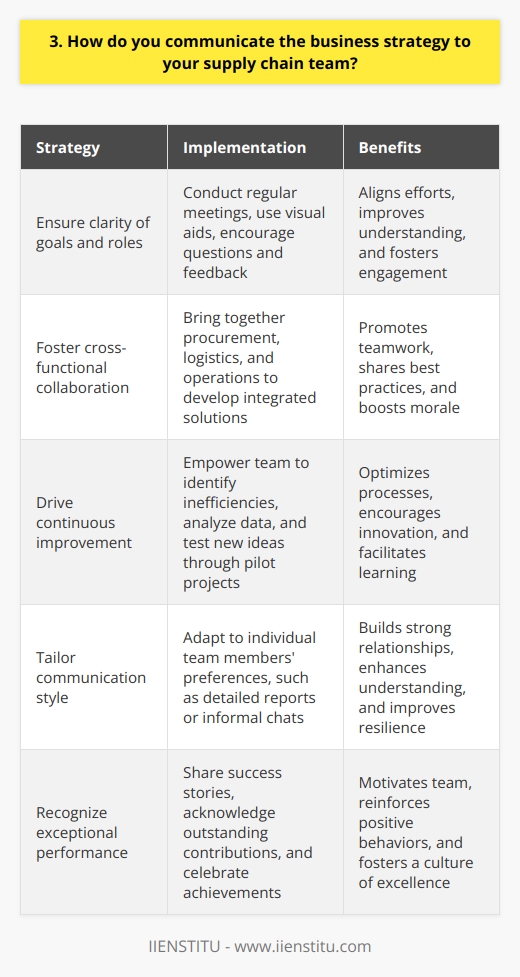
4. Can you describe a time when you had to adjust your supply chain strategy to accommodate changes in the business strategy?
In my previous role as a supply chain manager, I encountered a situation where our business strategy shifted towards expanding into new markets. This change required us to adjust our supply chain strategy to accommodate the increased demand and geographic diversity.
Assessing the Impact
I collaborated with cross-functional teams to assess the impact of the business strategy change on our supply chain operations. We identified potential bottlenecks, such as limited warehouse capacity and longer transportation routes, that could hinder our ability to meet the new market demands efficiently.
Developing a Flexible Strategy
To address these challenges, I led the development of a flexible supply chain strategy. We explored options like partnering with local suppliers, establishing regional distribution centers, and optimizing our transportation network. These initiatives aimed to reduce lead times, improve responsiveness, and minimize costs.
Implementing and Monitoring
I worked closely with my team to implement the revised supply chain strategy. We conducted thorough risk assessments, developed contingency plans, and established key performance indicators to monitor the effectiveness of our adjustments. Regular reviews and data analysis helped us identify areas for continuous improvement.
Throughout the process, I emphasized the importance of adaptability and collaboration. By fostering open communication and encouraging innovative problem-solving, we successfully aligned our supply chain strategy with the evolving business objectives. As a result, we were able to support the company's expansion efforts while maintaining high levels of customer satisfaction and operational efficiency.

5. How do you balance cost optimization with other strategic objectives in your supply chain?
Balancing cost optimization with other strategic objectives in the supply chain is a challenging but essential task. I've found that effective communication and collaboration across departments is key to striking the right balance.
Align Objectives
First, make sure everyone understands the overarching goals. Cost savings are important, but so are factors like quality, reliability, and sustainability. Work with stakeholders to prioritize and align these sometimes competing objectives.
Leverage Data Analytics
I'm a big believer in using data to drive decisions. Robust analytics can help identify opportunities to streamline processes, consolidate shipments, optimize inventory levels, and negotiate better rates - all while maintaining service levels.
Foster Innovation
Encourage your team to think creatively. I once ran a contest for cost-saving ideas and was blown away by the innovative solutions people came up with, from packaging redesigns to new recycling initiatives. Small changes can add up to big savings over time.
Monitor and Adjust
Supply chain conditions are always evolving. I've learned the importance of continuously monitoring key metrics and being agile enough to adapt strategies as needed. Regular check-ins with suppliers and customers help us stay on top of changing needs.
At the end of the day, it's about finding that sweet spot where we're operating lean and mean, but not at the expense of our other strategic priorities. It takes ongoing effort and a lot of cross-functional teamwork, but it's so satisfying when you get that balance right and everything is humming along smoothly.
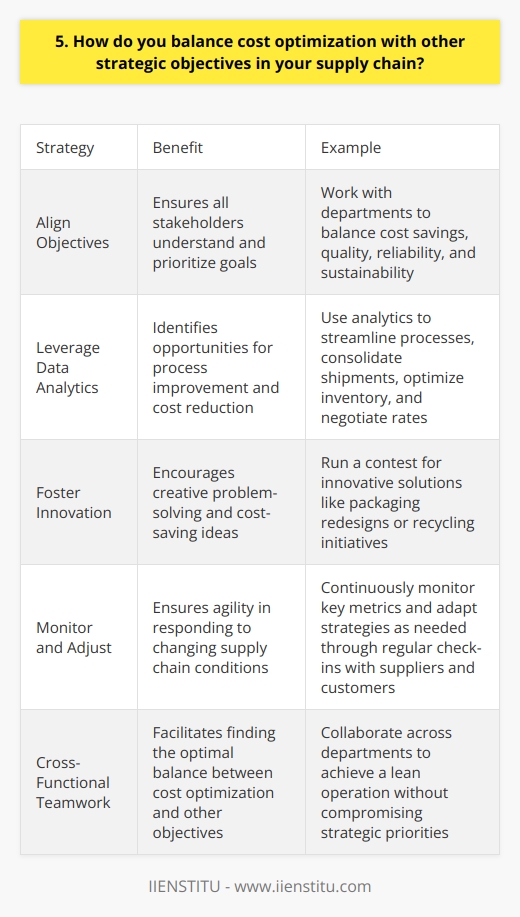
6. What role does technology play in aligning your supply chain with the business strategy?
Technology plays a crucial role in aligning supply chain with business strategy. It enables real-time data visibility and collaboration across the entire supply network. This allows companies to make informed decisions and respond quickly to changing market conditions.
Enhancing Agility and Responsiveness
Advanced technologies like AI, IoT, and blockchain help streamline processes and automate tasks. This increases supply chain agility and responsiveness. Companies can adapt to fluctuations in demand, optimize inventory levels, and improve customer service.
Real-World Example
I once worked with a retail client who implemented RFID technology in their supply chain. It allowed them to track inventory accurately in real-time. This led to a 20% reduction in stockouts and a 15% increase in sales.
Driving Innovation and Competitive Advantage
Technology enables companies to innovate and differentiate their offerings. By leveraging data analytics and AI, businesses can gain insights into customer preferences and market trends. This helps them develop new products and services that align with their overall strategy.
Personal Experience
In my previous role, we used predictive analytics to forecast demand for our products. This helped us optimize production planning and reduce waste. It was a game-changer for our business and gave us a competitive edge in the market.
Enabling Collaboration and Integration
Technology facilitates seamless collaboration and integration across the supply chain. Tools like cloud-based platforms and blockchain enable real-time information sharing and trust among partners. This leads to improved efficiency, reduced costs, and better decision-making.
My Thoughts
I believe that technology is the key to unlocking the full potential of supply chains. It enables companies to be more agile, innovative, and collaborative. However, it's important to choose the right technologies and implement them effectively to maximize their benefits.
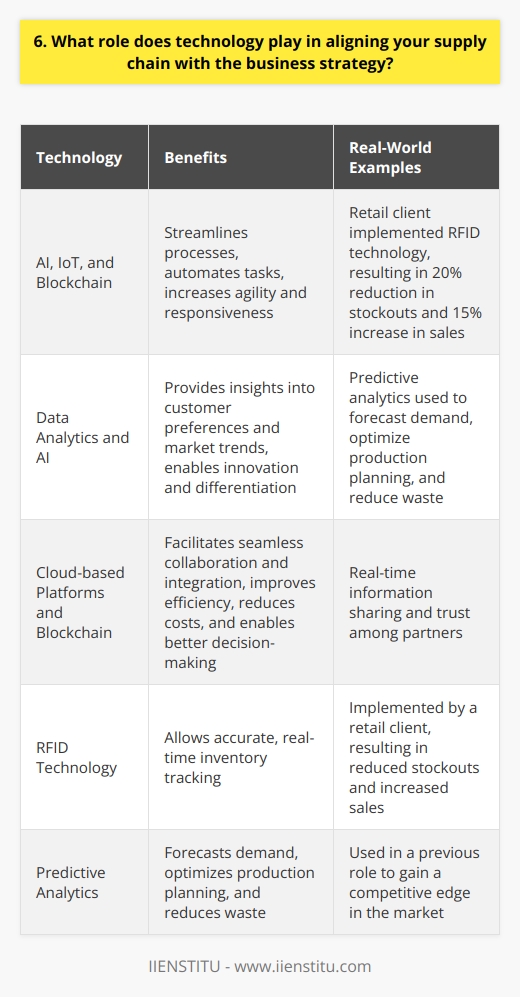
7. How do you measure the success of your supply chain in supporting the business strategy?
To measure the success of our supply chain in supporting the business strategy, I focus on several key metrics. First and foremost, I track our inventory levels and ensure we have the right products in stock. This helps us meet customer demand and avoid stockouts, which can lead to lost sales.
On-Time Delivery
Another important metric is on-time delivery. I work closely with our logistics partners to ensure orders are shipped promptly and arrive at their destination on schedule. By monitoring our on-time delivery rates, we can identify any bottlenecks or issues in the supply chain and take corrective action.
Cost Savings
I also measure the success of our supply chain by looking at cost savings. By negotiating better rates with suppliers, optimizing our transportation routes, and reducing waste, we can lower our overall supply chain costs. This helps improve our bottom line and frees up resources that can be invested in other areas of the business.
Supplier Performance
Finally, I keep a close eye on supplier performance. I regularly assess our suppliers' quality, reliability, and responsiveness. If a supplier isn't meeting our standards, I work with them to develop improvement plans or explore alternative sourcing options. By ensuring we have a strong and dependable supplier base, we can better support our business strategy and deliver value to our customers.
In my experience, measuring the success of our supply chain requires a holistic approach that takes into account multiple factors. By tracking these key metrics and continuously looking for ways to improve, we can ensure our supply chain is aligned with our overall business objectives and delivering the results we need to succeed.
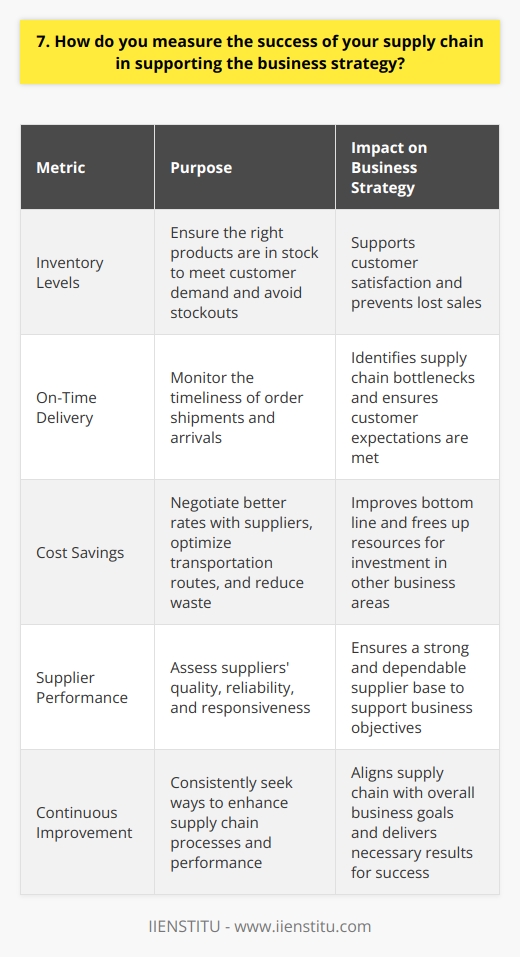
8. Can you discuss the importance of collaboration between supply chain and other departments in achieving strategic alignment?
Collaboration between supply chain and other departments is crucial for achieving strategic alignment in any organization. By working together, we can ensure that our goals and objectives are aligned across the board. This means that everyone is on the same page and working towards the same end result.
Benefits of Collaboration
When supply chain collaborates with other departments, such as sales, marketing, and finance, we can achieve several benefits:
Real-World Example
In my previous role, I witnessed firsthand the power of collaboration between supply chain and sales. By working closely together, we were able to optimize our inventory levels and reduce stockouts, which resulted in happier customers and increased sales. It wasn't always easy, but through regular communication and a willingness to listen and adapt, we achieved great results.
The Role of Technology
Technology can also play a big role in facilitating collaboration between departments. Tools like enterprise resource planning (ERP) systems and supply chain management software can help us share data and insights in real-time, making it easier to make informed decisions and respond quickly to changes.
The Human Element
Of course, technology is just one piece of the puzzle. At the end of the day, it's the people who make collaboration happen. It takes trust, respect, and a willingness to work together towards a common goal. That's why I believe in building strong relationships with my colleagues across departments and fostering a culture of collaboration and teamwork.
In summary, collaboration between supply chain and other departments is essential for achieving strategic alignment and driving business success. By working together, leveraging technology, and focusing on the human element, we can overcome challenges, optimize our operations, and deliver value to our customers.
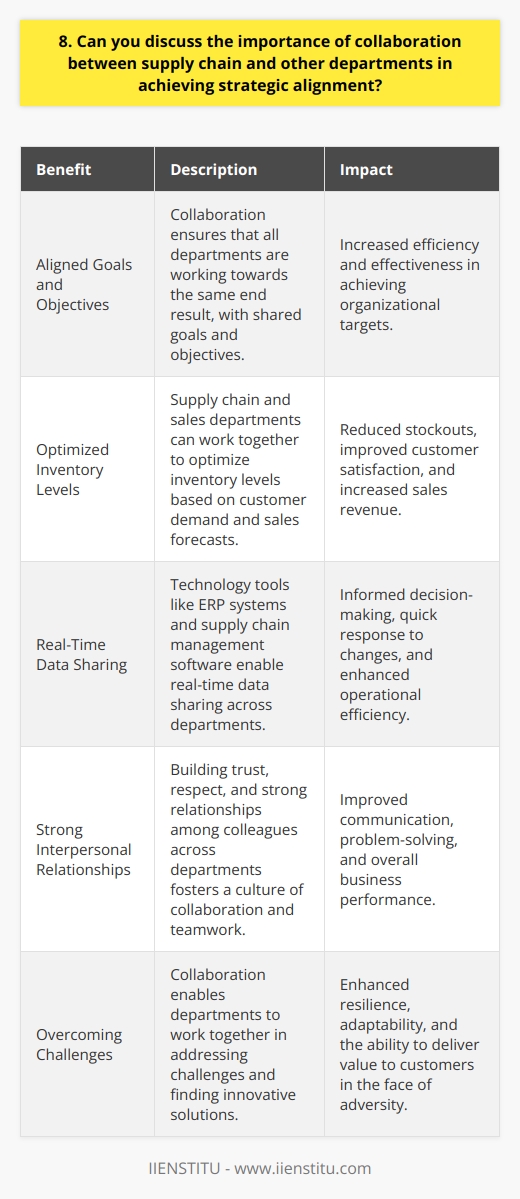
9. How do you ensure that your supply chain remains agile and responsive to changes in the business environment?
To keep our supply chain agile and responsive, I prioritize regular communication with suppliers and partners. Building strong relationships is key.
Monitoring Market Trends
I constantly monitor market trends and consumer behavior changes. Staying on top of shifting demands allows quick adjustments. For example, during the pandemic, we rapidly pivoted to supplying more home office equipment.
Leveraging Technology
Investing in the right supply chain technology is critical. I implemented an AI-powered demand forecasting system last year. It analyzes vast datasets to predict customer needs with uncanny accuracy.
Cloud-based inventory management software gives us real-time visibility across warehouses. We can move goods between locations seamlessly. RFID tracking has also boosted efficiency and transparency tremendously.
Contingency Planning
Having backup plans for various disruption scenarios is essential. I work with the team to map out potential risks. We devise strategies to mitigate issues like supplier delays, transportation snags, or sudden demand spikes.
Diversifying our supplier base has made us more resilient too. We're not dependent on a single source. Multiple options in different geographic regions reduce our vulnerability to localized problems.
Continuous Improvement
I'm a big believer in kaizen - the Japanese business philosophy of continuous improvement. We're always looking for ways to streamline processes and cut waste.
Cross-functional collaboration is a huge part of that. I love bouncing ideas around with colleagues from sales, finance, logistics. Diverse perspectives spark innovation.
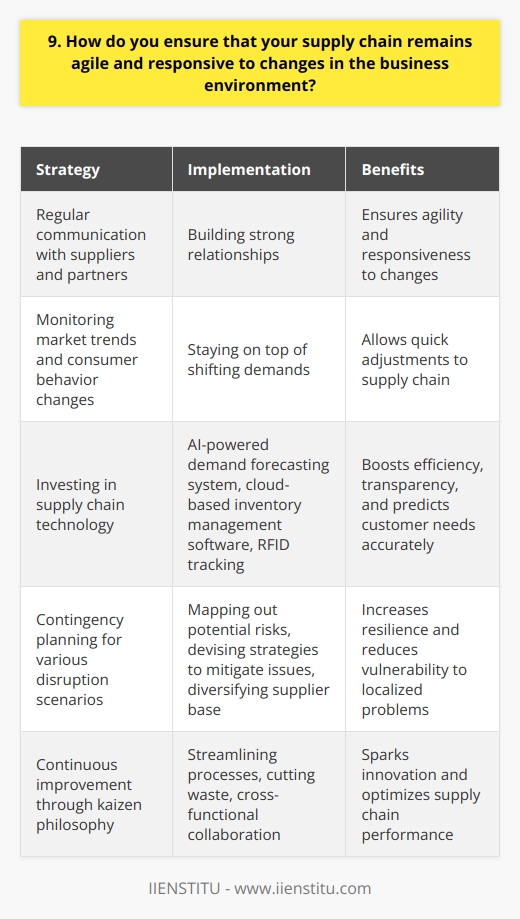
10. What are the key challenges you face in aligning supply chain goals with business strategy, and how do you overcome them?
Aligning supply chain goals with business strategy presents several challenges. Firstly, it requires effective communication and collaboration between different departments. I overcome this by regularly meeting with key stakeholders to discuss objectives and ensure everyone is on the same page.
Balancing Competing Priorities
Another challenge is balancing competing priorities, such as cost reduction versus quality control. In my experience, it's essential to carefully weigh the trade-offs and find a middle ground that supports the overall business strategy. I stay focused on the big picture while making tough decisions.
Adapting to Change
The business landscape is constantly evolving, which can make aligning supply chain goals difficult. I stay agile by monitoring market trends, anticipating disruptions, and being prepared to adjust plans as needed. Flexibility is key to staying aligned with shifting business needs.
Leveraging Technology
I've found that leveraging technology is crucial for overcoming alignment challenges. By implementing supply chain management software and data analytics tools, I gain visibility into key metrics and can make data-driven decisions that support business objectives. Tech helps bridge the gap between supply chain and strategy.
Finally, I believe building strong relationships with suppliers, partners, and internal teams is essential for alignment. I invest time in nurturing these connections, fostering trust, and creating a shared sense of purpose. When everyone is working towards common goals, alignment becomes much easier.
In summary, aligning supply chain with business strategy is an ongoing process that requires communication, flexibility, technology, and strong relationships. By staying focused on these key areas, I've been able to successfully overcome alignment challenges and drive results for the organization.
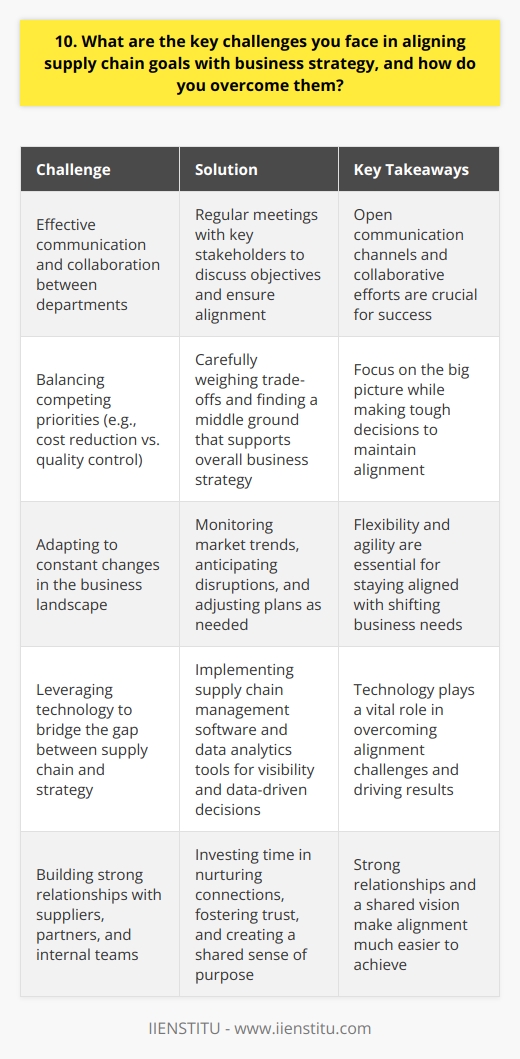
11. How do you prioritize supply chain initiatives based on their strategic importance?
When it comes to prioritizing supply chain initiatives, I always start by aligning them with the company's overall strategic goals. This ensures that our efforts are focused on the most impactful areas that will drive the business forward.
Assessing Impact and Urgency
I evaluate each initiative based on its potential impact and urgency. High-impact initiatives that address critical business needs take top priority. I also consider the timeline and resources required for implementation.
Collaborating with Stakeholders
Collaboration is key. I engage with stakeholders from various departments to gather insights and ensure alignment. Their input helps me make informed decisions and prioritize initiatives effectively.
Balancing Short-term and Long-term Benefits
It's important to strike a balance between short-term wins and long-term strategic value. I prioritize initiatives that deliver quick results while also investing in projects that lay the foundation for future growth and efficiency.
Continuous Review and Adjustment
Prioritization is an ongoing process. I regularly review the progress of initiatives and make adjustments as needed. This agility allows me to adapt to changing business needs and optimize our supply chain strategies.
By following this approach, I've successfully implemented supply chain initiatives that have reduced costs, improved customer satisfaction, and driven overall business performance. It's a methodology that I'm passionate about and have seen deliver real results.
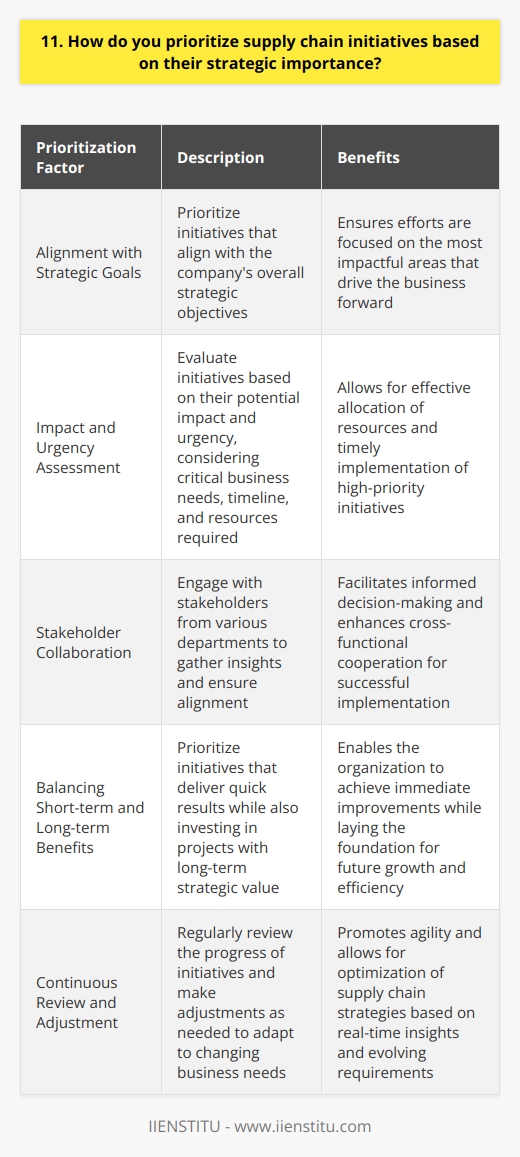
12. Can you provide an example of a successful supply chain project that directly supported the company's strategic objectives?
In my previous role as a Supply Chain Manager, I successfully led a project that aligned with our company's strategic objectives. The goal was to optimize our inventory management system and reduce carrying costs.
Identifying Areas for Improvement
I started by analyzing our current processes and identifying areas for improvement. We were holding excess inventory, leading to higher storage costs and reduced cash flow. I knew that streamlining our inventory could make a significant impact.
Collaborating with Cross-Functional Teams
I collaborated with cross-functional teams, including Sales, Marketing, and Finance, to gather insights and build consensus. Together, we reviewed historical sales data, forecasted demand, and set realistic inventory targets. This collaboration was key to ensuring buy-in across the organization.
Implementing a Just-in-Time (JIT) System
After careful planning, we implemented a Just-in-Time (JIT) inventory system. This meant working closely with our suppliers to ensure timely deliveries and adjusting our reorder points based on real-time demand. It was a complex undertaking, but the results were worth it.
Achieving Measurable Results
Through this project, we reduced our inventory carrying costs by 25% and improved our cash flow by $500,000 annually. More importantly, we were able to reinvest those savings into strategic initiatives that fueled our company's growth. It was a proud moment for me and a testament to the power of effective supply chain management.

13. How do you engage stakeholders across the organization to ensure supply chain alignment with business strategy?
In my experience, engaging stakeholders across the organization is crucial for aligning the supply chain with business strategy. I believe in building strong relationships with key players in various departments, such as sales, marketing, and finance. By fostering open communication and collaboration, I can gain valuable insights into their needs and goals.
Understanding Business Objectives
I make it a priority to deeply understand the company's overall business objectives. I engage in discussions with senior management to grasp their vision and strategies. This knowledge helps me align the supply chain initiatives with the bigger picture.
Cross-Functional Collaboration
I actively participate in cross-functional meetings and projects. By working closely with other departments, I can identify opportunities for supply chain optimization that support their goals. For example, I once collaborated with the sales team to redesign our distribution network, resulting in faster delivery times and increased customer satisfaction.
Data-Driven Decision Making
I rely on data and analytics to drive supply chain decisions. I engage with IT and data teams to access relevant information. By presenting data-backed proposals, I can effectively communicate the value of supply chain initiatives to stakeholders across the organization.
Continuous Improvement
I believe in the power of continuous improvement. I regularly seek feedback from stakeholders to identify areas where the supply chain can better support their needs. By implementing their suggestions and keeping them informed of progress, I maintain their trust and support.
In summary, engaging stakeholders across the organization is about building relationships, understanding their objectives, and demonstrating the value of supply chain in driving business success.

14. What role does data analytics play in driving strategic decision-making in your supply chain?
Data analytics plays a crucial role in driving strategic decision-making throughout our supply chain. By leveraging advanced analytics tools and techniques, we gain valuable insights that inform our strategies and optimize operations.
Identifying Trends and Patterns
We analyze vast amounts of data from various sources to identify trends and patterns. This helps us anticipate demand fluctuations, detect potential disruptions, and proactively address challenges. By staying ahead of the curve, we can make informed decisions that keep our supply chain running smoothly.
Real-Time Visibility and Optimization
Data analytics provides us with real-time visibility into our supply chain processes. We monitor key performance indicators, track shipments, and optimize routes to ensure timely deliveries. This level of visibility allows us to make data-driven decisions on the fly, adapting to changing circumstances and maximizing efficiency.
Collaborative Decision-Making
Analytics enables collaborative decision-making across our organization. By sharing insights and data-driven recommendations, we foster cross-functional collaboration. This approach ensures that all stakeholders have the information they need to make informed decisions, aligning our efforts towards common goals.
Continuous Improvement and Innovation
Data analytics is at the heart of our continuous improvement initiatives. We constantly analyze performance metrics to identify areas for optimization. By leveraging predictive analytics and machine learning, we can anticipate future challenges and develop innovative solutions. This data-driven approach allows us to stay ahead in a competitive market.
In my experience, embracing data analytics has been a game-changer for our supply chain. It has empowered us to make smarter, faster decisions that drive operational excellence and customer satisfaction. I'm excited to continue leveraging the power of data to shape our strategic direction and achieve our goals.
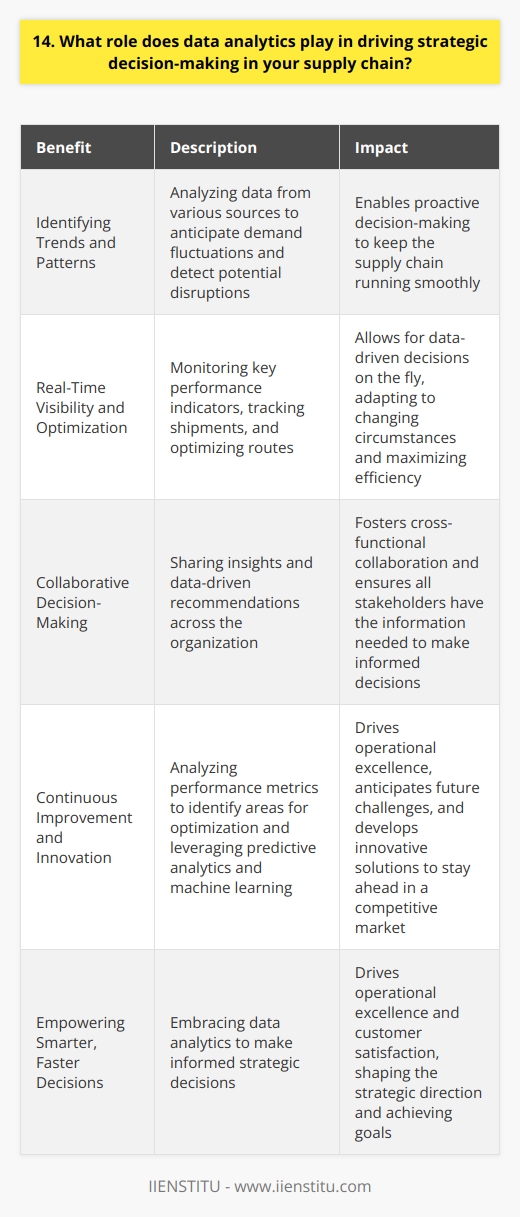
15. How do you foster a culture of continuous improvement in your supply chain to support the evolving business strategy?
I foster a culture of continuous improvement in the supply chain by empowering my team members. I encourage them to share their ideas and insights regularly. This collaborative approach helps us identify areas for improvement and develop innovative solutions.
Aligning with Business Strategy
To ensure our efforts support the evolving business strategy, I stay closely connected with our leadership team. I seek to understand the company's goals and priorities. This alignment allows us to focus our continuous improvement initiatives on the most impactful areas.
Leveraging Data and Technology
Data-driven decision making is crucial for driving continuous improvement. I champion the use of advanced analytics and technologies. These tools help us uncover inefficiencies, optimize processes, and enhance visibility across the supply chain.
Fostering a Learning Culture
I believe in creating an environment where learning and growth are valued. I encourage my team to pursue training opportunities and share knowledge. By fostering a learning culture, we can continuously expand our capabilities and adapt to changing business needs.
Ultimately, my approach to continuous improvement is rooted in collaboration, alignment, data, and learning. By engaging my team, leveraging insights, and staying agile, we can drive meaningful improvements that support the company's evolving strategy.
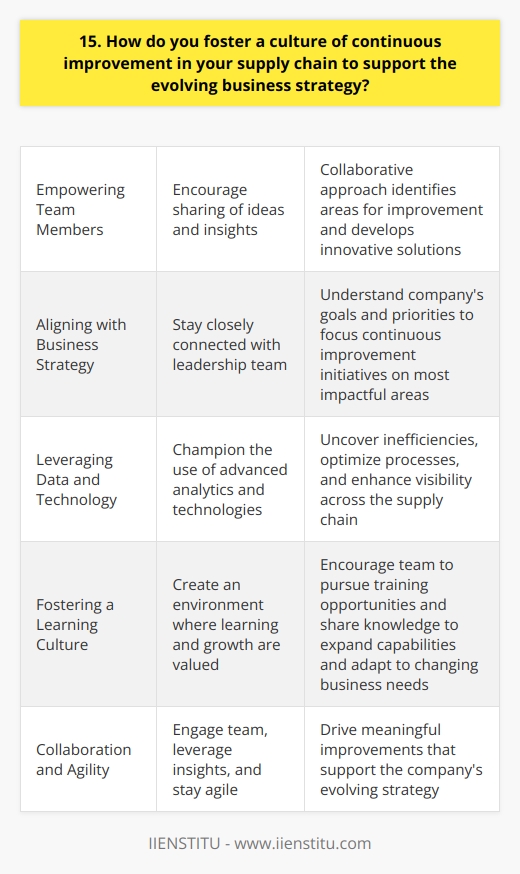
16. Can you discuss the impact of globalization on aligning supply chain goals with business strategy?
Globalization has had a profound impact on aligning supply chain goals with overall business strategy. In today's interconnected world, companies must adapt their supply chains to remain competitive and meet evolving customer demands.
Leveraging Global Sourcing
One key aspect of globalization is the ability to source materials and products from around the world. By diversifying suppliers and tapping into global markets, businesses can reduce costs, improve quality, and mitigate risks. I've seen firsthand how our company's strategic sourcing initiatives have helped us stay ahead of the competition.
Streamlining Logistics and Distribution
Globalization has also transformed logistics and distribution networks. Advanced transportation and communication technologies enable faster, more efficient delivery of goods worldwide. In my role, I've worked to optimize our global distribution channels, resulting in shorter lead times and improved customer satisfaction.
Adapting to Local Markets
While globalization offers many benefits, it's crucial to adapt supply chain strategies to local market conditions. Cultural differences, regulations, and consumer preferences vary across regions. I believe the key is finding the right balance between global standardization and local customization.
Collaboration and Partnerships
To succeed in a globalized environment, strong collaboration and partnerships are essential. Building trust with suppliers, logistics providers, and customers fosters long-term success. Some of my most rewarding experiences have involved developing mutually beneficial relationships with our global partners.
In summary, globalization has reshaped how companies align supply chain goals with overall business objectives. By embracing global opportunities while adapting to local needs, businesses can create agile, resilient supply chains that drive competitive advantage.
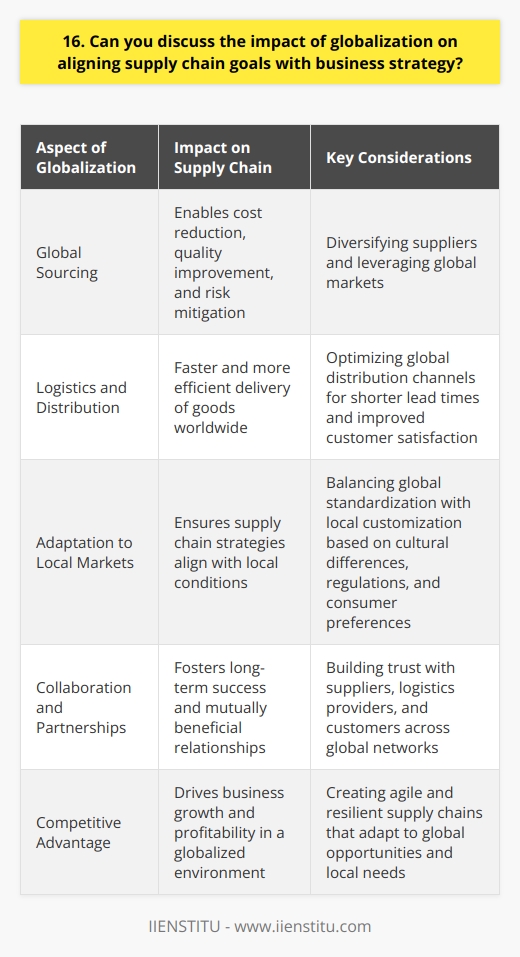
17. How do you manage risk in your supply chain to minimize disruptions to the business strategy?
I manage risk in my supply chain by proactively identifying potential disruptions and developing contingency plans. I closely monitor supplier performance, market trends, and geopolitical events that could impact our operations. By diversifying our supplier base and maintaining adequate inventory levels, we minimize the risk of shortages.
Collaboration and Communication
Regular communication with suppliers is crucial. I build strong relationships founded on trust and transparency. We work together to identify risks and develop mitigation strategies. Collaboration helps us respond quickly to any issues that arise.
Data-Driven Decisions
I leverage data analytics to gain insights into our supply chain. By analyzing historical data and forecasting future demand, we can optimize inventory levels and anticipate potential disruptions. Data helps us make informed decisions to minimize risk.
Continuous Improvement
I believe in continuous improvement. We regularly review our supply chain processes and look for opportunities to streamline operations. By implementing lean principles and eliminating waste, we reduce the risk of disruptions.
Adaptability and Resilience
In today's fast-paced business environment, adaptability is key. I foster a culture of resilience within our supply chain team. We are prepared to quickly adjust our strategies in response to changing circumstances. By being proactive and adaptable, we minimize the impact of disruptions on our business.

18. What are the key performance indicators (KPIs) you use to track supply chain alignment with business strategy?
I track several key performance indicators to ensure our supply chain aligns with our business strategy. First, I monitor inventory turnover and days of supply to optimize stock levels and reduce carrying costs. This helps us maintain a lean and efficient supply chain.
On-Time Delivery
Another critical KPI is on-time delivery. I work closely with our logistics partners to ensure orders arrive on schedule. By tracking this metric, we can identify and address any bottlenecks or delays in our fulfillment process.
Cost Savings
I also focus on cost savings throughout the supply chain. By negotiating better rates with suppliers and optimizing transportation, we can reduce expenses and improve profitability. Last quarter, my team implemented a new warehouse management system that cut our labor costs by 15%.
Customer Satisfaction
Finally, I believe customer satisfaction is the ultimate measure of supply chain performance. I regularly survey our clients to gauge their happiness with our service. When issues arise, I personally reach out to understand their concerns and find solutions. Recently, I visited a customer's facility to troubleshoot a recurring late shipment problem.
By monitoring these KPIs and taking a hands-on approach, I ensure our supply chain operates smoothly and supports our company's overall goals. It's challenging work, but I find it incredibly rewarding to see the tangible results of my efforts.
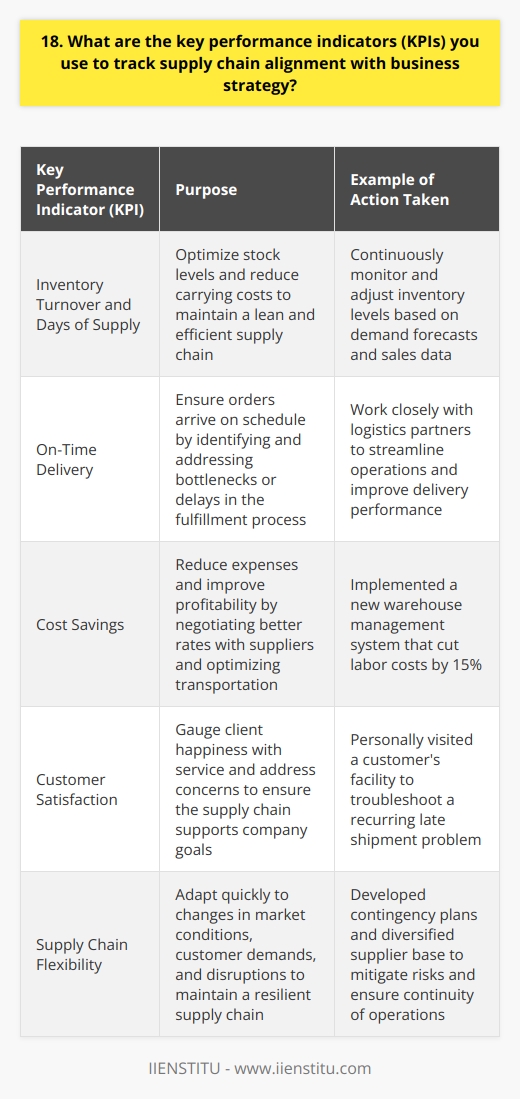
19. How do you ensure that your supply chain team understands and is committed to the business strategy?
As a supply chain leader, I ensure my team is aligned with our business strategy through several key practices. Firstly, I prioritize clear and frequent communication about our company's goals and objectives. This involves regular team meetings where we discuss how our work directly contributes to the organization's success.
Leading by Example
I believe in leading by example and demonstrating my own commitment to our strategy. When my team sees me actively working towards our shared goals, it inspires them to do the same. I make a point of celebrating our successes and recognizing team members who go above and beyond in supporting our strategic initiatives.
Encouraging Collaboration and Innovation
Collaboration is essential for a cohesive supply chain team. I foster an environment where ideas are freely shared and everyone's input is valued. By encouraging innovation, we can find creative solutions that drive our business forward. I also invest in my team's professional development, providing training and resources to help them grow and take ownership of their roles.
Measuring Progress and Adapting
Finally, I believe in setting clear metrics to measure our progress against strategic goals. We regularly review our performance and make data-driven decisions to optimize our supply chain. By staying agile and adapting to challenges, we can ensure our team remains aligned with the evolving needs of the business.
Ultimately, my approach is rooted in communication, collaboration, and a shared sense of purpose. By empowering my team and leading with transparency, I build a supply chain that is resilient, responsive, and deeply committed to our company's success.

20. Can you describe a situation where misalignment between supply chain and business strategy led to negative consequences?
In a previous role, I witnessed the consequences of misalignment between supply chain and business strategy firsthand. Our company had set ambitious growth targets, but failed to properly communicate them to the supply chain team.
Lack of Coordination and Planning
As a result, we found ourselves consistently understocked on key products. We simply didn't have the inventory to meet the increased demand that marketing and sales had worked so hard to generate.
It was a frustrating situation for everyone involved. Customers were disappointed, sales targets were missed, and morale suffered.
The Root of the Problem
Looking back, the root issue was a lack of cross-functional coordination and planning. The business strategy was developed in a silo, without input from supply chain on what was realistically achievable.
Lessons Learned
From this experience, I learned the critical importance of aligning supply chain capabilities with business objectives. It's not enough to just set goals – you need to ensure you have the operational foundation to deliver on them.
Now, in my current role, I always strive for close collaboration between supply chain and other business functions. By working together to develop integrated strategies, we can avoid those kinds of painful misalignments and set ourselves up for success.
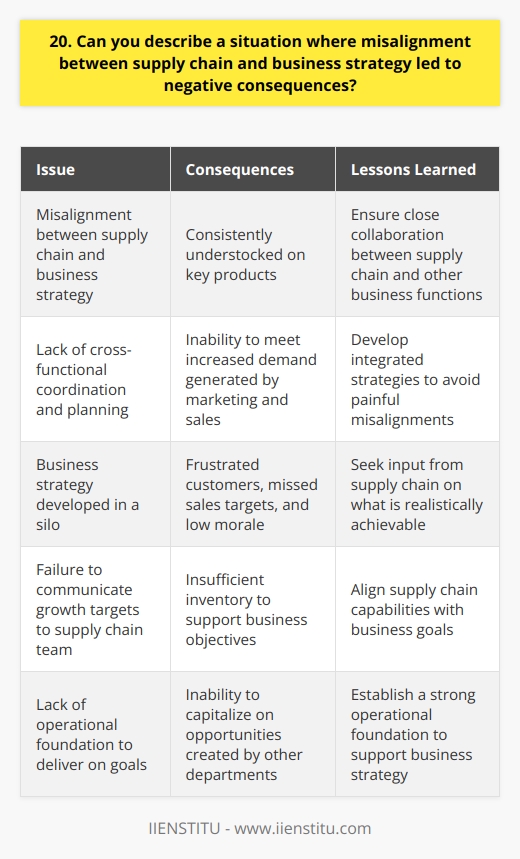
21. How do you leverage supplier relationships to support the company's strategic objectives?
I believe that strong supplier relationships are crucial for achieving the company's strategic objectives. By fostering open communication and collaboration with suppliers, we can ensure a reliable supply chain and access to high-quality materials.
Building Trust and Transparency
I strive to build trust with suppliers through frequent, honest discussions about our needs and expectations. This transparency helps align our goals and prevents misunderstandings that could disrupt operations or product quality.
Example from Previous Role
In my last position, I worked closely with a key raw materials supplier. By meeting regularly to review forecasts and discuss industry trends, we were able to anticipate demand spikes and avoid shortages. This partnership allowed us to maintain steady production and meet customer deadlines consistently.
Leveraging Supplier Expertise
Our suppliers are experts in their specialized fields. I tap into that knowledge by involving them early in product development and process improvement initiatives. Their insights can spark innovations and efficiencies that give us a competitive edge.
Cross-Functional Collaboration
I also act as a bridge between suppliers and internal teams like R&D, marketing, and manufacturing. By facilitating information sharing and aligning supplier capabilities with company goals, we can bring better products to market faster and more cost-effectively. Ultimately, I believe investing in supplier partnerships is investing in our company's long-term success.
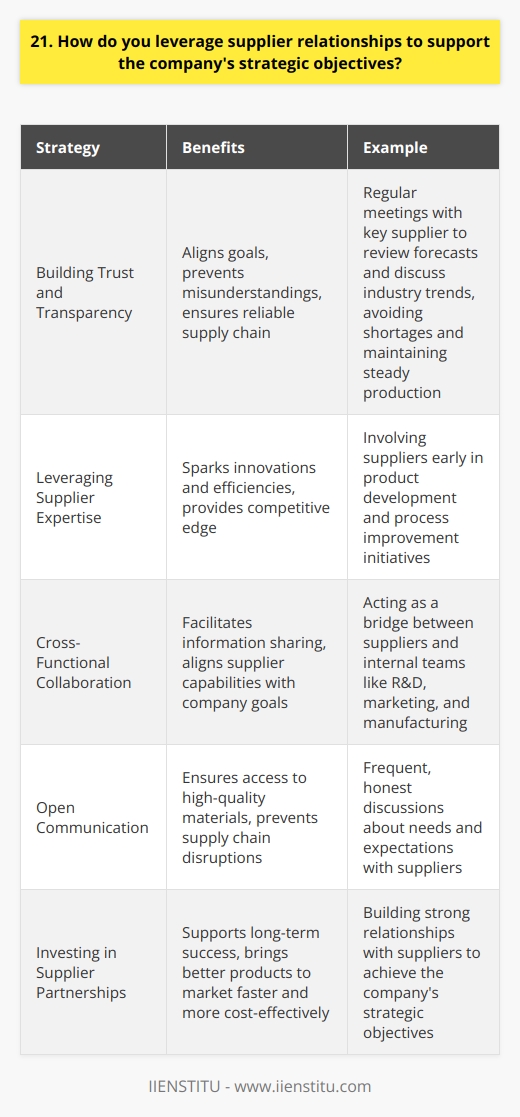
22. What role does sustainability play in aligning your supply chain with the business strategy?
Sustainability plays a crucial role in aligning your supply chain with your business strategy. By integrating sustainable practices into your supply chain management, you can create a more resilient and adaptable system that supports your overall business goals.
Reducing Environmental Impact
One key aspect of sustainability in supply chain management is reducing your company's environmental footprint. This can involve sourcing materials from eco-friendly suppliers, optimizing transportation routes to minimize emissions, and implementing recycling and waste reduction programs throughout your supply chain. By making sustainability a priority, you demonstrate your commitment to corporate social responsibility and appeal to environmentally-conscious consumers.
Enhancing Efficiency and Cost Savings
Sustainable supply chain practices often go hand in hand with increased efficiency and cost savings. For example, by streamlining your logistics network and consolidating shipments, you can reduce transportation costs while also cutting down on fuel consumption and emissions. Similarly, by investing in energy-efficient equipment and technologies, you can lower your operating expenses while minimizing your environmental impact.
Building Strong Supplier Relationships
Collaborating with suppliers who share your commitment to sustainability can help you build stronger, more reliable partnerships. By working together to implement sustainable practices and innovate new solutions, you can create a more transparent and accountable supply chain that benefits both your business and the environment.
Adapting to Changing Market Demands
As consumer preferences shift towards more sustainable products and practices, aligning your supply chain with these values becomes increasingly important. By embracing sustainability as a core part of your business strategy, you can stay ahead of the curve and position your company for long-term success in a rapidly evolving market.
In my experience, I've seen firsthand how sustainability can drive positive change throughout an organization. When I worked at my previous company, we made a concerted effort to green our supply chain by partnering with local suppliers, reducing packaging waste, and optimizing our transportation network. Not only did these initiatives help us reduce our environmental footprint, but they also led to significant cost savings and improved our brand reputation among customers who valued sustainability.
Ultimately, by making sustainability a key pillar of your supply chain strategy, you can create a more resilient, efficient, and socially responsible business that is better equipped to thrive in the long run.
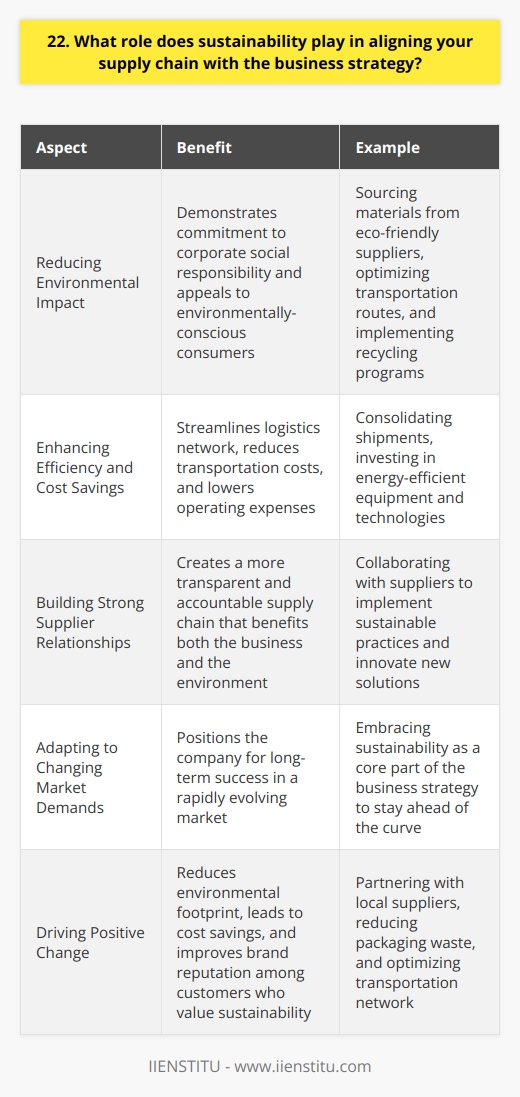
23. How do you balance the need for standardization and customization in your supply chain to support the business strategy?
<h3>Balancing Standardization and Customization</h3><h4>Leveraging a Hybrid Approach</h4>In my experience, the key to balancing standardization and customization is adopting a hybrid approach. I've found that standardizing core processes and components helps ensure consistency and efficiency. At the same time, allowing for customization in certain areas enables flexibility to meet unique customer needs.<h4>Aligning with Business Strategy</h4>It's crucial to align the supply chain with the overall business strategy. For example, when I worked at XYZ Company, our strategy focused on cost leadership. This meant we prioritized standardization to streamline operations and reduce costs. However, we still offered limited customization options to cater to our largest clients' specific requirements.<h4>Collaborating with Stakeholders</h4>Balancing standardization and customization requires close collaboration with both internal and external stakeholders. I make it a point to regularly engage with sales, marketing, and product development teams to understand evolving customer preferences. This helps inform where we need to offer more customization. I also work closely with suppliers to identify opportunities for standardization that can drive efficiency without sacrificing quality or customer satisfaction.<h5>Continuous Improvement</h5>Striking the right balance is an ongoing process. I believe in continuously monitoring and adjusting the mix of standardization and customization. By staying attuned to changing market dynamics and customer needs, I can refine the supply chain to optimize performance and support the business strategy.<h6>The Bottom Line</h6>At the end of the day, it's about finding the sweet spot that allows us to efficiently deliver value to customers while remaining agile and responsive. Balancing standardization and customization is a critical part of that equation, and it's something I'm passionate about getting right.
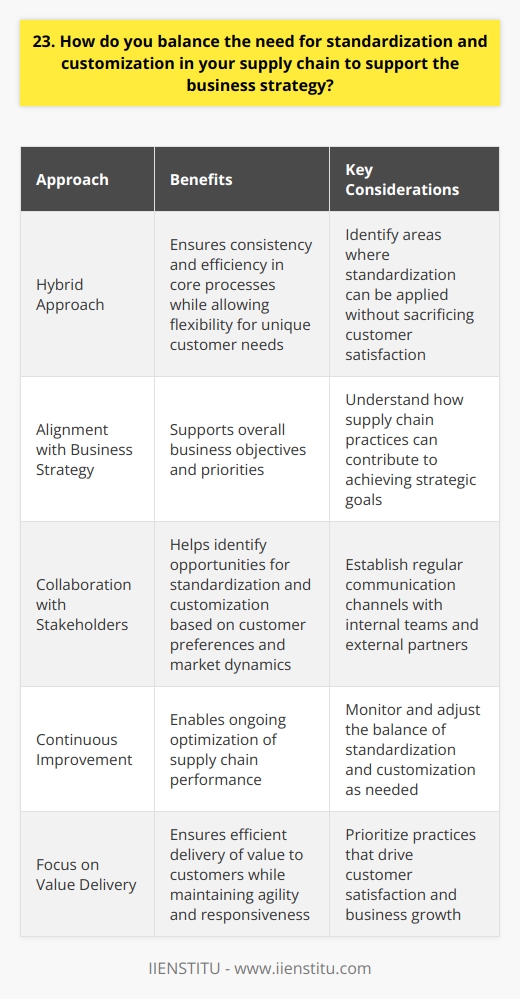
24. Can you discuss the importance of talent development in building a supply chain that supports the business strategy?
Talent development plays a crucial role in building a supply chain that supports the business strategy. It ensures that the right people with the right skills are in place to execute the strategy effectively. Here are some key points to consider:
Aligning Talent with Business Objectives
I've seen firsthand how important it is to align talent development with the company's overall goals. By identifying the specific skills and competencies needed to achieve those objectives, we can create targeted training programs that help employees grow and contribute to the organization's success.
Fostering a Culture of Continuous Learning
In my experience, a culture that encourages continuous learning is essential for staying competitive. By providing opportunities for employees to expand their knowledge and skills, we can build a more adaptable and resilient supply chain. This could include on-the-job training, mentoring, and access to external resources like workshops and conferences.
Attracting and Retaining Top Talent
Investing in talent development helps attract and retain the best people. When employees see that the company is committed to their growth and development, they're more likely to stay engaged and motivated. This leads to lower turnover, which is critical for maintaining a stable and efficient supply chain.
Promoting Collaboration and Innovation
I believe that fostering collaboration and innovation is key to building a supply chain that can adapt to changing business needs. By bringing together people with diverse skills and perspectives, we can encourage creative problem-solving and develop new ideas that drive the business forward.
In conclusion, talent development is a critical component of building a supply chain that supports the business strategy. By aligning talent with business objectives, fostering continuous learning, attracting top talent, and promoting collaboration, we can create a supply chain that is agile, resilient, and able to deliver value to the organization.
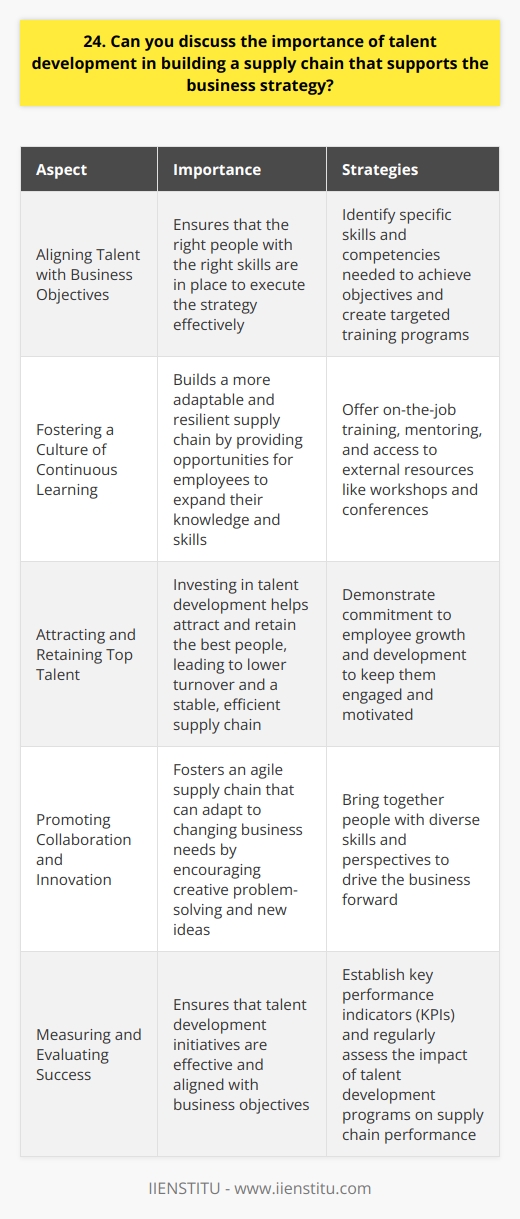
25. How do you stay informed about industry trends and best practices in supply chain strategy alignment?
I stay informed about industry trends and best practices in supply chain strategy alignment through several methods. Firstly, I regularly read industry publications and attend webinars to learn about the latest developments. I also participate in online forums and discussions with other professionals in the field.
Networking and Conferences
Attending conferences and networking events has been invaluable for staying up-to-date. I recently attended the Supply Chain Management Association's annual conference, where I learned about innovative strategies for aligning supply chain processes with business objectives. The keynote speaker shared a fascinating case study about how a company reduced costs and improved efficiency by restructuring their supply chain.
Continuous Learning
I believe in continuous learning and always seek out opportunities to expand my knowledge. Last year, I completed an online course on supply chain analytics, which taught me how to use data to make informed decisions. I apply these skills in my current role to identify areas for improvement and implement solutions.
Collaborating with Colleagues
Collaborating with colleagues has also been essential for staying informed. I regularly meet with team members from different departments to discuss challenges and share best practices. Last month, we worked together to streamline our inventory management process, which resulted in significant cost savings.
By combining these various approaches, I ensure that I'm always up-to-date on the latest trends and best practices in supply chain strategy alignment. I'm passionate about this field and committed to continuously improving my skills and knowledge.
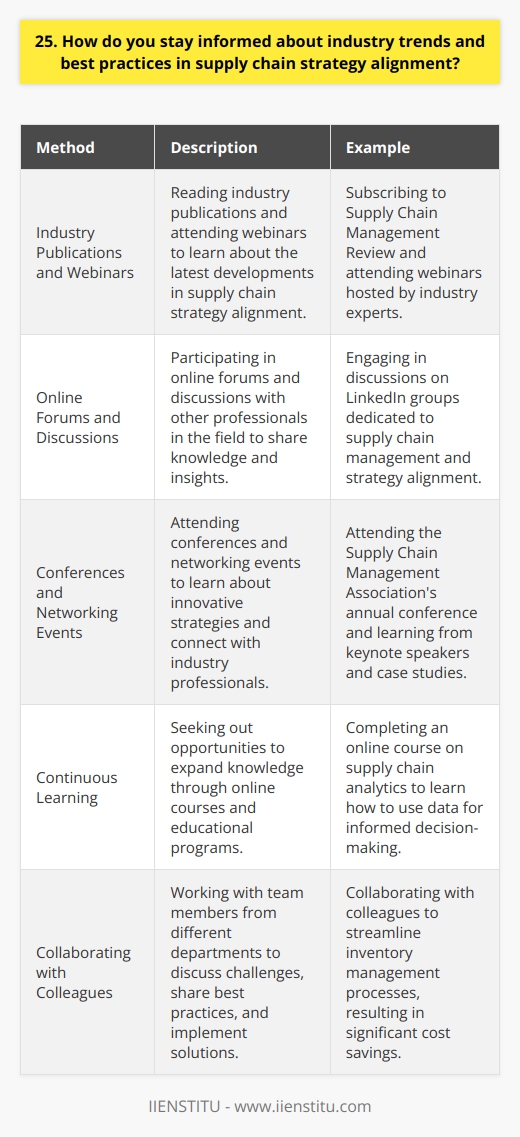
26. What steps do you take to ensure that your supply chain is prepared for disruptive events that could impact the business strategy?
I have developed a comprehensive strategy to ensure our supply chain remains resilient during disruptive events. This approach involves close collaboration with suppliers, detailed contingency planning, and leveraging advanced technology for real-time monitoring and swift decision-making.
Building Strong Supplier Relationships
I believe in fostering open communication and trust with our suppliers. I regularly engage with them to understand their challenges and work together on solutions. This partnership approach helps us navigate disruptions more effectively.
Diversifying Supplier Base
To mitigate risks, I have diversified our supplier network across different regions. This ensures that if one area faces disruption, we can quickly shift sourcing to maintain continuity. I also continuously evaluate and onboard new suppliers to enhance our resilience.
Robust Contingency Planning
I lead my team in developing detailed contingency plans for various disruption scenarios. We identify potential risks, assess their impact, and outline clear action steps. These plans are regularly reviewed and updated to stay ahead of evolving threats.
Stress Testing and Simulations
To validate our contingency plans, we conduct periodic stress tests and simulations. This helps us identify gaps, refine our response strategies, and ensure our team is well-prepared to handle real-world disruptions effectively.
Leveraging Technology for Agility
I have implemented advanced supply chain management systems that provide real-time visibility across our network. This enables us to quickly detect disruptions, assess their impact, and make data-driven decisions to mitigate risks and maintain operations.
By combining strong supplier partnerships, robust planning, and innovative technology, I am confident in our ability to navigate disruptions and deliver on our business strategy.

27. How do you use benchmarking to assess your supply chain's performance in supporting the business strategy?
I use benchmarking to assess my supply chain's performance by comparing key metrics against industry leaders and competitors. This helps me identify areas where our supply chain excels and where it needs improvement.
Identifying Relevant Metrics
First, I determine which supply chain metrics are most critical for supporting our business strategy. These might include cost per unit, lead times, inventory turns, and on-time delivery rates. The specific KPIs depend on our company's unique goals and priorities.
Gathering Benchmark Data
Next, I research to gather benchmark data on those metrics from top-performing companies in our industry. Sources include industry associations, analyst reports, and conversations with colleagues at non-competing firms. While not always easy, obtaining reliable benchmarks is essential for a meaningful comparison.
Analyzing Gaps
With our performance data and the benchmarks in hand, I analyze where gaps exist. Maybe our inventory turns lag behind the industry average, suggesting we're tying up too much capital. Or perhaps our lead times are longer, impacting customer satisfaction. The size and nature of the gaps point to improvement priorities.
Developing an Action Plan
Finally, I work with my team to develop targeted initiatives to close the gaps. We might streamline processes, invest in automation, or strengthen supplier partnerships. The goal is to bring our metrics in line with or exceeding the benchmarks, enhancing our supply chain's contribution to company success.
Continuous Improvement
Benchmarking isn't a one-time exercise for me. I believe in regularly assessing our supply chain against evolving benchmarks. It's a continuous improvement process to keep pace in an ever-advancing field. Plus, celebrating the progress we've made is a great morale booster for the team!
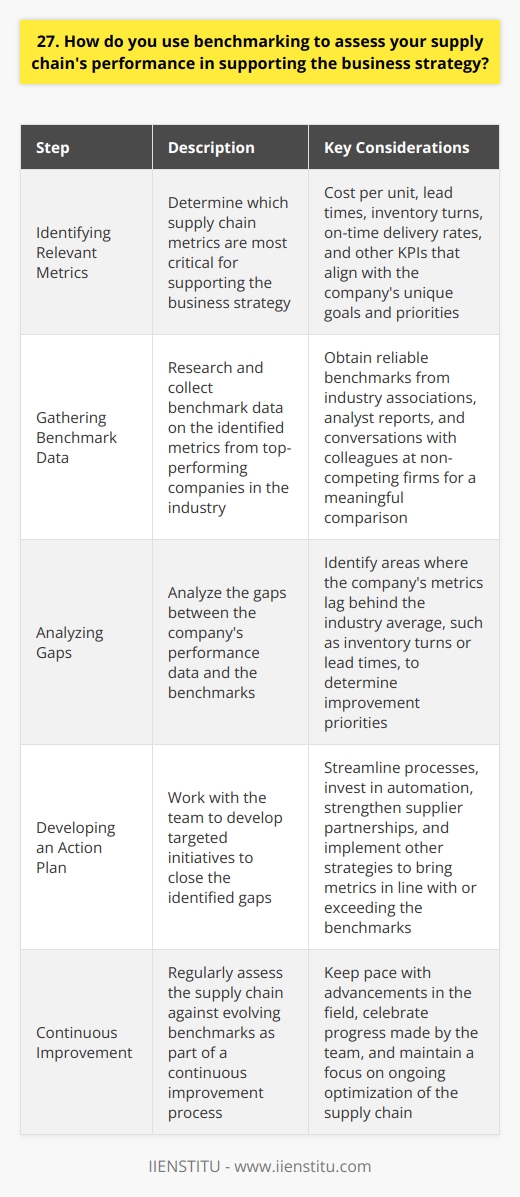
28. Can you describe a time when you had to make a tough decision in your supply chain to prioritize the business strategy?
In my previous role as a supply chain manager, I encountered a situation where I had to make a tough decision to prioritize the business strategy. Our company was facing a shortage of raw materials due to a supplier's unexpected production issues. This shortage threatened to disrupt our manufacturing process and potentially delay deliveries to our key customers.
Assessing the Situation
I quickly gathered my team to assess the situation and explore possible solutions. We analyzed our inventory levels, production schedules, and customer commitments. It became clear that we didn't have enough raw materials to fulfill all our orders on time.
Prioritizing Business Strategy
I realized that we needed to prioritize our business strategy and make a tough call. We had to decide which customers and orders to prioritize based on their strategic importance to our company. This meant potentially disappointing some customers in the short term.
Communicating with Stakeholders
I communicated transparently with our stakeholders, explaining the situation and our proposed plan of action. I worked closely with our sales team to manage customer expectations and find alternative solutions where possible. We also collaborated with our supplier to expedite the delivery of raw materials.
Implementing the Plan
We implemented our plan, focusing our limited resources on our strategic customers and orders. It wasn't an easy decision, but it was necessary to align with our business priorities. We kept all stakeholders informed throughout the process and worked diligently to minimize the impact on our customers.
Learning from the Experience
This experience taught me the importance of being proactive, decisive, and adaptable in supply chain management. It highlighted the need to align supply chain decisions with overall business strategy, even when faced with tough choices. I learned to communicate effectively, manage expectations, and find creative solutions in challenging situations.
In the end, we successfully navigated the raw material shortage and minimized the impact on our key customers and business objectives. This experience strengthened my ability to make difficult decisions under pressure while keeping the big picture in mind.
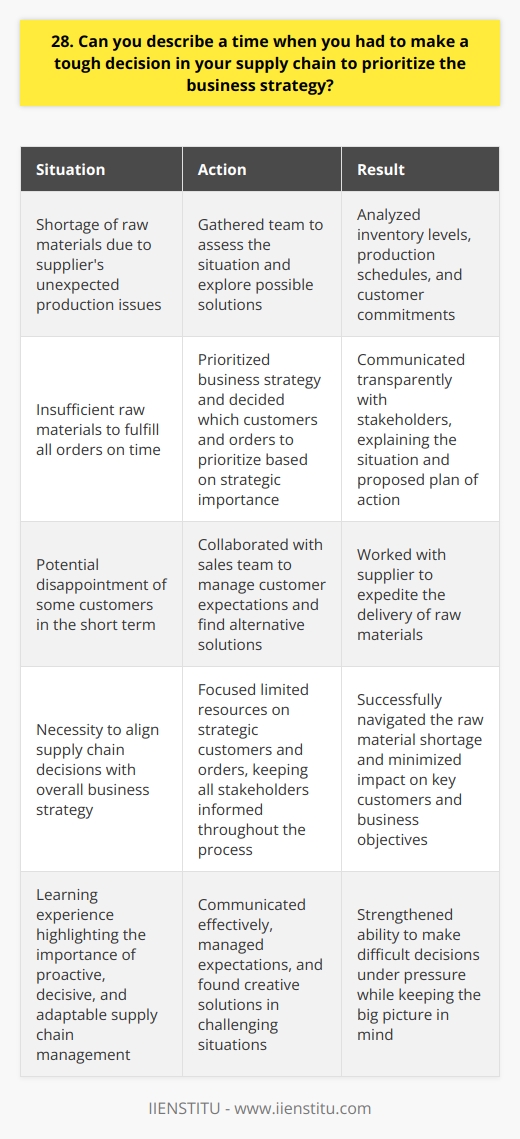
29. How do you foster innovation in your supply chain to drive strategic advantage?
I foster innovation in the supply chain by encouraging collaboration and open communication among team members. I believe that when everyone feels heard and valued, they are more likely to share their ideas and insights. This leads to a culture of innovation where new solutions can emerge.
Leveraging Technology
I also leverage technology to streamline processes and gain real-time visibility into the supply chain. By using advanced analytics and AI-powered tools, I can identify inefficiencies, predict potential disruptions, and make data-driven decisions. This helps me stay agile and responsive to changing market conditions.
Partnering with Suppliers
Another key strategy I use is partnering closely with suppliers. I build strong relationships based on trust and mutual benefit. By collaborating on product development, quality improvement, and cost reduction initiatives, we can drive innovation together. I've seen firsthand how these partnerships can lead to game-changing breakthroughs.
Embracing Continuous Improvement
Finally, I foster a mindset of continuous improvement throughout the supply chain. I encourage my team to experiment, learn from failures, and constantly seek out new and better ways of doing things. By creating a culture that values creativity, flexibility, and adaptability, I believe we can stay ahead of the curve and maintain a competitive edge in the marketplace.
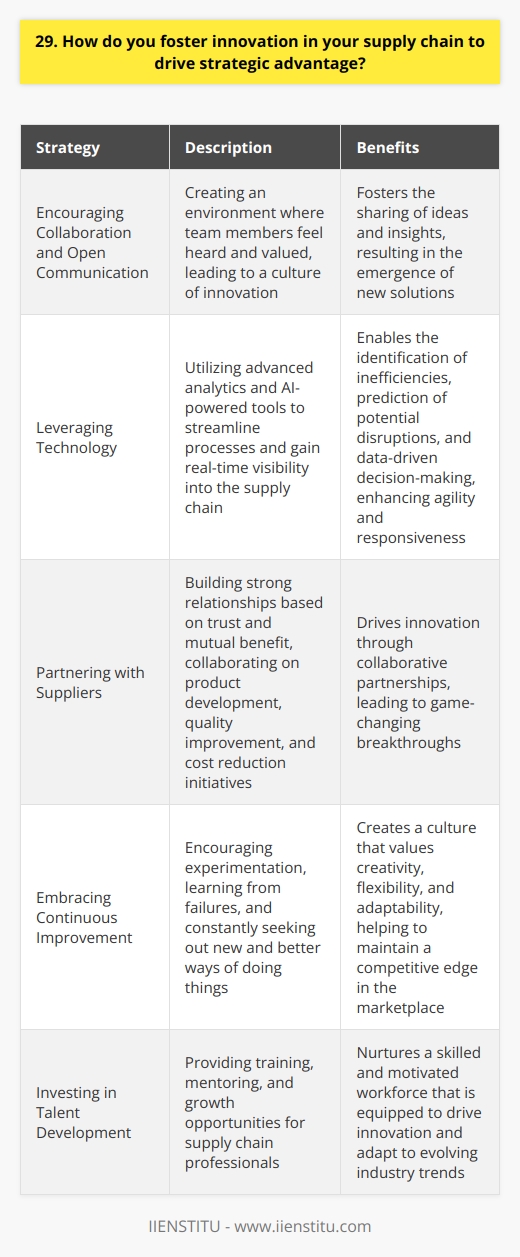
30. What advice would you give to a company struggling to align its supply chain goals with its business strategy?
As a supply chain professional, I understand the challenges of aligning supply chain goals with business strategy. In my experience, effective communication and collaboration between departments are crucial for success.
Develop a Clear Strategy
The first step is to clearly define your company's business strategy and objectives. What are your priorities and goals? Once you have a solid understanding of your strategy, you can align your supply chain accordingly.
Involve Key Stakeholders
Bring together representatives from different departments, such as sales, marketing, finance, and operations. Encourage open dialogue and brainstorming sessions to identify areas where the supply chain can better support business objectives.
Assess Your Current Supply Chain
Take a close look at your current supply chain processes and identify any bottlenecks or inefficiencies. Are there areas where you can streamline operations or reduce costs? Look for opportunities to optimize your supply chain to better support your business goals.
Leverage Technology
Invest in supply chain technology solutions that can help you improve visibility, automate processes, and make data-driven decisions. The right technology can help you align your supply chain with your business strategy more effectively.
Focus on Continuous Improvement
Aligning your supply chain with your business strategy is an ongoing process. Continuously monitor and measure your supply chain performance against your business objectives. Be willing to adapt and make changes as needed to stay on track.
Remember, aligning your supply chain with your business strategy takes time and effort, but it's worth it. By working collaboratively and leveraging the right tools and processes, you can achieve better results for your company.
